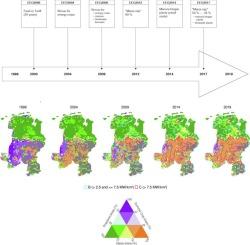基于遥感的生物能源政策对农业土地覆盖变化影响的长期评估:以德国Weser-Ems地区沼气为例
IF 8
1区 环境科学与生态学
Q1 ENVIRONMENTAL SCIENCES
引用次数: 0
摘要
气候变化、人口增长和其他全球性挑战正在给有限的土地资源,特别是农业用地带来压力,以满足对食物、能源载体、化工原料和生态系统服务的需求。本研究旨在了解沼气业的发展对农业用地造成的压力。德国的威瑟-埃姆斯地区是一个传统的农业区,被用作研究区域。遥感(RS)和机器学习方法,结合综合管理和控制系统(IACS)的数据,用于预测和绘制农业土地覆盖,并观察其在20年期间的变化,从德国可再生能源法案(EEG)建立的时候开始,该法案为能源作物沼气工厂提供了保证的上网电价和奖金支付。观测到的土地覆盖变化与研究区沼气生产能力的发展有关。结果表明,2004 - 2014年间,玉米种植的优势地位总体上升,分别取代了西部和北部地区的其他夏季作物和草地。此外,主要的土地覆被变化发生在沼气厂装机容量密度增加的地区,表明该地区沼气生产发展与农业土地覆被变化之间存在直接关系。由于玉米青贮用于沼气和饲养牛,因此采用简化的参考因子来估算玉米作为牛饲料的用量。这一分析进一步强化了最初的发现,并强调了沼气开发与玉米种植面积扩大之间的联系。所开发的方法可以作为政策实施后影响分析的工具,并为支持长期生物经济监测提供有用的见解。本文章由计算机程序翻译,如有差异,请以英文原文为准。

Remote sensing-based long-term assessment of bioenergy policy impact on agricultural land cover change: A case study of biogas in the Weser-Ems region in Germany
Climate change, population growth, and other global challenges are putting pressure on the limited land resources, in particular on agricultural land, to satisfy the demands for food, energy carriers, raw materials for the chemical industry, and ecosystem services. This study was conducted to understand the pressure applied on agricultural land due to the development of biogas sector. The Weser-Ems region in Germany, which is a traditional agricultural area, was used as a study area. Remote sensing (RS) and machine learning methods, in combination with data of the integrated administration and control system (IACS), were used to predict and map the agricultural land cover, and to observe its change over a 20 years period, starting at the time when the German renewable energy act (EEG) was established, which provided a guaranteed feed-in tariff and bonus payments for energy crop-based biogas plants. The observed land cover changes were related to the development of biogas production capacities in the studied area. The results show an overall increasing dominance of maize cultivation between the years 2004 and 2014, replacing other summer crops and grassland respectively in the southern and the northern regions of Weser-Ems. Further, major land cover changes have occurred in areas with an increased density of biogas plant installed electric capacity, indicating that there is a direct relation between biogas production development and agricultural land cover change in the region. Since the maize silage is used for biogas and feeding cattle, a simplified reference factor was applied to estimate the amount of maize used as cattle feed. This analysis further strengthened the initial findings and emphasized the link between biogas development and the expansion of maize cultivation areas. The developed approach can serve as a tool for ex-post policy impact analysis and provide useful insights to support long-term bioeconomy monitoring.
求助全文
通过发布文献求助,成功后即可免费获取论文全文。
去求助
来源期刊

Science of the Total Environment
环境科学-环境科学
CiteScore
17.60
自引率
10.20%
发文量
8726
审稿时长
2.4 months
期刊介绍:
The Science of the Total Environment is an international journal dedicated to scientific research on the environment and its interaction with humanity. It covers a wide range of disciplines and seeks to publish innovative, hypothesis-driven, and impactful research that explores the entire environment, including the atmosphere, lithosphere, hydrosphere, biosphere, and anthroposphere.
The journal's updated Aims & Scope emphasizes the importance of interdisciplinary environmental research with broad impact. Priority is given to studies that advance fundamental understanding and explore the interconnectedness of multiple environmental spheres. Field studies are preferred, while laboratory experiments must demonstrate significant methodological advancements or mechanistic insights with direct relevance to the environment.
 求助内容:
求助内容: 应助结果提醒方式:
应助结果提醒方式:


